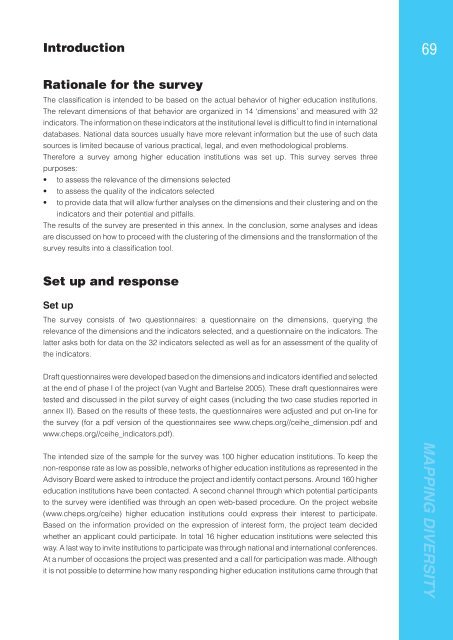Mapping Diversity: Developing a European Classification of ... - U-Map
Mapping Diversity: Developing a European Classification of ... - U-Map
Mapping Diversity: Developing a European Classification of ... - U-Map
Create successful ePaper yourself
Turn your PDF publications into a flip-book with our unique Google optimized e-Paper software.
Introduction<br />
69<br />
Rationale for the survey<br />
The classifi cation is intended to be based on the actual behavior <strong>of</strong> higher education institutions.<br />
The relevant dimensions <strong>of</strong> that behavior are organized in 14 ‘dimensions’ and measured with 32<br />
indicators. The information on these indicators at the institutional level is diffi cult to fi nd in international<br />
databases. National data sources usually have more relevant information but the use <strong>of</strong> such data<br />
sources is limited because <strong>of</strong> various practical, legal, and even methodological problems.<br />
Therefore a survey among higher education institutions was set up. This survey serves three<br />
purposes:<br />
• to assess the relevance <strong>of</strong> the dimensions selected<br />
• to assess the quality <strong>of</strong> the indicators selected<br />
• to provide data that will allow further analyses on the dimensions and their clustering and on the<br />
indicators and their potential and pitfalls.<br />
The results <strong>of</strong> the survey are presented in this annex. In the conclusion, some analyses and ideas<br />
are discussed on how to proceed with the clustering <strong>of</strong> the dimensions and the transformation <strong>of</strong> the<br />
survey results into a classifi cation tool.<br />
Set up and response<br />
Set up<br />
The survey consists <strong>of</strong> two questionnaires: a questionnaire on the dimensions, querying the<br />
relevance <strong>of</strong> the dimensions and the indicators selected, and a questionnaire on the indicators. The<br />
latter asks both for data on the 32 indicators selected as well as for an assessment <strong>of</strong> the quality <strong>of</strong><br />
the indicators.<br />
Draft questionnaires were developed based on the dimensions and indicators identifi ed and selected<br />
at the end <strong>of</strong> phase I <strong>of</strong> the project (van Vught and Bartelse 2005). These draft questionnaires were<br />
tested and discussed in the pilot survey <strong>of</strong> eight cases (including the two case studies reported in<br />
annex II). Based on the results <strong>of</strong> these tests, the questionnaires were adjusted and put on-line for<br />
the survey (for a pdf version <strong>of</strong> the questionnaires see www.cheps.org//ceihe_dimension.pdf and<br />
www.cheps.org//ceihe_indicators.pdf).<br />
The intended size <strong>of</strong> the sample for the survey was 100 higher education institutions. To keep the<br />
non-response rate as low as possible, networks <strong>of</strong> higher education institutions as represented in the<br />
Advisory Board were asked to introduce the project and identify contact persons. Around 160 higher<br />
education institutions have been contacted. A second channel through which potential participants<br />
to the survey were identifi ed was through an open web-based procedure. On the project website<br />
(www.cheps.org/ceihe) higher education institutions could express their interest to participate.<br />
Based on the information provided on the expression <strong>of</strong> interest form, the project team decided<br />
whether an applicant could participate. In total 16 higher education institutions were selected this<br />
way. A last way to invite institutions to participate was through national and international conferences.<br />
At a number <strong>of</strong> occasions the project was presented and a call for participation was made. Although<br />
it is not possible to determine how many responding higher education institutions came through that<br />
MAPPING DIVERSITY

















